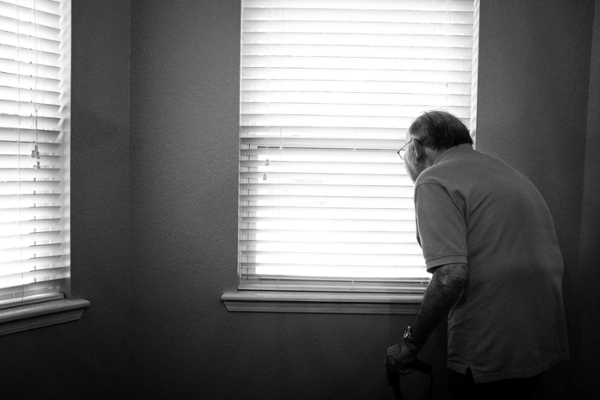
Long-term care in the era of COVID-19: There is no place like home
This issue of JSGS Policy Brief is part of a series dedicated to exploring and providing evidence-based analysis, policy ideas, recommendations and research conclusions on the various dimensions of the pandemic, as it relates here in Canada and internationally.
By Dan Florizone, Executive-in-Residence, Johnson Shoyama Graduate School of Public PolicyAs of May 2020, 80 per cent of all COVID-19-related deaths in Canada were residents of long-term care facilities. These tragic deaths not only highlight a myriad of issues with the existing model of institutional long-term care, but have created a public call for immediate action to modernize seniors’ care. While the need to change our approach to long-term care predated this pandemic, a new urgency for reform has emerged because of it. True reform, however, needs to be tempered through a broader policy consideration—why do we default to institutional solutions for seniors’ care in the first place?
A Growing Seniors Population
The latest Statistics Canada (Statistics Canada, 2018) data tells us that in 2016, 32 per cent of people aged 85 years and older lived in collective dwellings, including nursing homes, long-term care facilities, and senior citizen residences, an increase of 23 per cent from 2011. Between 2011 and 2016, the number of people 85 years of age and older increased by 19.4 per cent, approximately four times the rate for the overall Canadian population. The highest proportion of people 85 years of age and older was in Saskatchewan, at 2.5 per cent. Estimates from population projections indicate the number of those 85 years of age and older will increase rapidly over the next few decades because of increased life expectancy.
Based on utilization data and projected demands, by 2035 Canada will need an estimated 199,000 additional long-term care beds (Gibbard, 2017). But, that is based on our past model of care, simply expanded according to demographic growth.
Expansion of institutions can and should be disrupted through innovation—bringing care to where people live—allowing them to age-in-place. Newer models can maximize independence, and quality of life, by allowing seniors to remain in their homes for as long as possible. This is not a risk-free alternative, but rather a trade-off allowing seniors the option to live as independently as possible, for as long as possible. For many seniors, it is a trade-off worth taking.
Reform not Improvement
Long-term care institutions bring residents together who tend to be older, frail and have a myriad of underlying health conditions. Care in these settings is delivered in close proximity, often within confined and shared spaces. Residents regularly congregate for meals, socialization and activities. All these conditions are conducive to viral spread of COVID-19, resulting in significant morbidity and mortality. The public has taken notice. The current call for change is based on a laundry list of long-standing issues: low quality and safety of care, lack of accountability, lack of regulation, underfunding, the poor state of facilities, low staffing levels; inadequate staff training and compensation; lack of administrative oversight; private versus public delivery; and, poor infection control practices. These issues, though not comprehensive, are symptoms for a model of unhealthy care. Dealing with some symptoms may lead to short-term improvements, but the entire approach must be overhauled in order to establish a healthy model.
Of course, not all institutions are alike. The problem is the high degree of variability in the quality of care provided across Canada. In addition, policies, standards, and staffing all vary, as do the state of facilities. As a province, Saskatchewan has experienced fewer COVID-19 outbreaks in facilities, and in the few areas outbreaks were experienced, they were managed effectively. However, public health measures to manage outbreaks, while effective, have come at a considerable strain to residents and families—with lock-down type procedures, physical isolation, as well as restriction from gathering for meals and recreation. The cost of keeping the virus out has meant even greater social isolation.
Our History with Institutional Models of Care
Saskatchewan has close to 8,900 long term care beds (75 per cent public, 20 per cent non-profit, 5 per cent for profit) and 4,200 personal care homes (100 per cent privately funded and delivered). Models of institutional care are as old as the province. While many other care institutions have come and gone throughout Saskatchewan’s history, such as orphanages and mental health asylums, institutional models of long-term care for seniors and prisons (incidentally two major hotspots for COVID-19) remain. The appeal of the large-scale institution, in the post-industrial era, was based on the success of the large factory assembly line, promoting efficiency through a division of labour, segregation of job duties, cohorting and establishment of rigid routines, all leading to large, bureaucratic organizations.
The first industrial-scale care institution built in Saskatchewan was a mental health asylum in North Battleford, followed by a second mental health asylum in Weyburn, and subsequently the establishment of training schools providing care for those with cognitive disabilities. These early facilities were massive, with more than 1,000 residents in each of North Battleford, Weyburn and Moose Jaw, rivaling the size of a large rural community. They grew their own food, raised their own livestock, and attempted to achieve a certain level of self-sufficiency. Labour was inexpensive, and patients were expected to contribute where possible as part of their therapy. Care was basic and crude. For patients, policies were dehumanizing, leading to isolation and separation from their families, neighbors and community.
These institutions were plagued by large upfront capital investments, rigid designs using bricks and mortar (and steel and concrete), limited flexibility, considerable maintenance and upkeep costs, a division of labour that requires a scale of 30 or more residents to operate efficiently, and resulting high operating costs.
Historic problems with institutional care have always centered on several areas of concern. At the forefront is quality of life.
The Move Away from Institutions

With time, as therapies, medications, technology, modern models and understanding of care emerged, it became increasingly apparent that institutions were not ideal places for care. In these and similar institutions, residents, families and ultimately the public called for change. During the past 50 years, there has been a growing call to close many of these institutions in favour of community-based approaches that reintegrate vulnerable citizens into society, into community, and into neighborhoods.
Over several decades, the problems with institutions led to the movement towards deinstitutionalization, resulting in the closure of mental health asylums, boarding schools, residential schools, orphanages, and training schools. In their place, small group and residential homes were introduced (four to five residents), community supports were put in place, and individualized care and home care were developed and expanded.
Our current system of home care was developed in Saskatchewan in the 1970s and 1980s, based on a social model of care. This was a departure from the classic ‘medical model’ and allowed for the delivery of supports to include home maintenance, home housekeeping, meals and meal preparation, personal care, medication management and direct care. Since inception, there has been a steady erosion and, in some areas such as home maintenance, a complete retraction of social supports delivered by home care. Medical type services have expanded—creating a strong set of home medical services, offered as acute-care substitution.
Since the early 1990s, Saskatchewan has fallen behind in making the necessary investments in home care that would balance the need for both health and social care at home. Keeping clients at home, living independently, with services that expanded and contracted according to need, is the ultimate aim. Unfortunately, constrained service offerings led to hospitalization and institutionalization the moment risk or cost was viewed by administrators, care givers, or family members as above an established threshold. Similar to episodic care, the value of the entire home care journey was no longer seen as relevant. Rather, costs and experience were measured at a point in time: hit the threshold and institutionalize. A far better alternative is to maximize independence, supporting a higher quality of life, throughout the care journey.
Strong leadership in Saskatchewan has mitigated many of the issues arising from institutional care of seniors. Long-term care leaders have brought about improvements to the model of care by encouraging community involvement, developing gardens and paths on the grounds, relaxing institutional routines, supporting resident independence, and creating smaller clusters/pods of care (Cleman, et al.) with multi-skilled and dedicated staff in a more home-like atmosphere. If smaller groups/pods within larger institutions is optimal, what if we take the next step to create smaller group homes and integrate them in communities and neighborhoods? Care at home is the preferred choice; care close to home, in the neighborhood, is the alternative.
Modernizing Seniors Care
The model that emerges in the future must be based upon a new set of principles that maximize independence and quality of life. That means more options that are community-based, providing care and support at home or as close to home as possible. Where relocating from one’s own home is required, we need small group homes that are more intimate with flexible and tailored schedules and care provided by staff each known by name.
Options must take into account care that is:
- at home or as close to home as possible, and if not at home—in a home-like setting;
- culturally appropriate;
- safe;
- aesthetically pleasing;
- scalable with services based on evolving and emerging health needs, allowing seniors to age in place;
- accommodating of spouses and partners;
- in close proximity to family and friends;
- provided by employees that residents know and who know them; and,
- affordable.
The inherent advantage of smaller homes includes:
- locations throughout residential areas and in the neighborhood—allowing seniors to remain close to home, close to friends and in familiar surroundings;
- care that is more intimate and personal;
- staff that can multi-task and take on a full range of job duties (personal care, meal preparation, housekeeping, activities);
- activities that take advantage of community amenities (park spaces, recreational facilities);
- neighbors who can support and participate in care;
- residents can easily get to know each other;
- the ability to avoid or limit any outbreaks to a small number of staff and residents;
- care that is scalable; and,
- homes can be built quickly and affordably, to residential standards, renovated as required and repurposed if needed.
One can easily imagine, in the near future, having small group homes acting as a hub of care, decentralizing care to a neighborhood or small community level, similar to having primary schools located in close proximity to family homes. A new model of long-term care would mandate care in an individual’s own home,with home care, local respite, palliative and activity programs delivered in home. And as care needs evolve and grow, services are easily scaled up. Day services could be available locally. If and when care at home is no longer an option, care can be provided down the road, within the neighborhood. And as it turns out, this proposed model is better and cheaper and more humane.
One day we will be the ones needing this care. We owe it to our senior citizens to make this change now.
ISSN 2369-0224 (Print) ISSN 2369-0232 (Online)
References
Koren MJ. Person-centered care for nursing home residents: the culture-change movement. Health Affairs 2010; 29(2):312-317.
Coleman MT, Looney S, O’Brien J, et al. The Eden Alternative: Findings after 1 year of implementation. J Gerontol Med Sci 2002;57:M422-M427.
Stone RI, Reinhard SC, Bowers B, et al. 2002. Evaluation of the Wellspring model for improving nursing home quality.
https://www.commonwealthfund.org/sites/default/files/documents/___media_files_publications_fund_report_2002_aug_evaluation_of_the_wellspring_model_for_improving_nursing_home_quality_stone_we llspringevaluation_pdf.pdf (accessed November 12, 2018).
Wiley-Blackwell. September 15, 2011. Small group homes are better for many dementia patients and their families, study suggests. www.sciencedaily.com/releases/2011/09/110915083649.htm (accessed November 11, 2018).
Care Quality Commission. The state of adult social care services 2014 to 2017. Findings from CQC’s initial programme of comprehensive inspections in adult social care. https://www.cqc.org.uk/sites/default/files/20170703_ASC_end_of_programme_FINAL2.pdf (accessed November 11, 2018)
Baldwin R, Chenoweth L, Dela Rama M, et al. Does size matter in aged care facilities? A literature review of the relationship between the number of facility beds and quality. Health Care Manage Rev 2017;42(4):315-327.
Yoon JY, Brown RL, Bowers BJ, et al. Longitudinal psychological outcomes of the small-scale nursing home model: a latent growth curve zero-inflated Poisson model. Int Psychogeriatr 2015; 27(6):1009–1016.
Kiely DK, Flacker JM. The protective effect of social engagement on 1-year mortality in a long-stay nursing home population. J Clin Epidemiol 2003; 56(5):472–478.
Statistics Canada. August 14, 2018. Census Program key indicators by geography. https://www12.statcan.gc.ca/censusrecensement/stats/statgeo2016.cfm?LANG=E&GEOCODE=01 (accessed November 11, 2018)
Statistics Canada. 2017. Focus on Geography Series, 2016 Census. Statistics Canada Catalogue no. 98-404X2016001. Ottawa, Ontario. Data products, 2016 Census
Statistics Canada. May 3, 2017. Age and sex, and type of dwelling data: Key results from the 2016 Census. https://www150.statcan.gc.ca/n1/daily-quotidien/170503/dq170503a-eng.htm (accessed November 11, 2016).
Statistics Canada. July 1, 2015. Canada’s population estimates: Age and sex. The Daily. Ottawa: Statistics Canada. http://www.statcan.gc.ca/daily-quotidien/150929/dq150929b-eng.htm (accessed November 11, 2018).
Statistics Canada. July 23, 2018. Census in Brief. A portrait of the population aged 85 and older in 2016 in Canada. https://www12.statcan.gc.ca/census-recensement/2016/as-sa/98-200-x/2016004/98-200x2016004-eng.cfm (accessed November 10, 2018).
Statistics Canada. 2017. Focus on Geography Series, 2016 Census. Statistics Canada Catalogue no. 98-404X2016001. Ottawa, Ontario. Data products, 2016 Census.
Gibbard R. Sizing Up the Challenge: Meeting the Demand for Long-Term Care in Canada. Ottawa: The Conference Board of Canada, 2017.
Dan Florizone

Prior to joining the Johnson Shoyama Graduate School of Public Policy as an Executive-in-Residence in 2018, Dan Florizone served as the President and CEO of the Saskatoon Health Region (2014-2017), as Deputy Minister of Education and Deputy Minister Responsible for Lean (2013-14), as the Deputy Minister of Health (2008-2013), and as an Assistant Deputy Health Minister. In addition to these roles, he served as the CEO of the Five Hills Health Region (Moose Jaw and Area), the Moose Jaw-Thunder Creek Health District, the South-East Health District (Estevan and area), Canora-Invermay-Norquay, and was the CEO of Wilkie Union Hospital. He has participated in many national and international initiatives, committees and projects, serving as Chairperson of Saskatchewan’s Health Quality Council, and Board Member on the Canadian Patient Safety Institute and Mental Health Commission of Canada.

